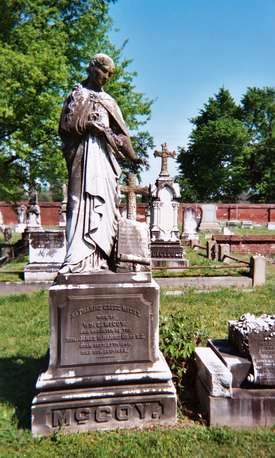 Happy Halloween. In the spirit of the holiday I think we should visit the graveyards of Augusta. Well, two at least. Augusta, founded in 1736 and 3 years younger than Savannah, is the second oldest city in Georgia. As a result, there's a lot of dead people around. The oldest cemetery is Magnolia, which bounds both Laney Walker and East Boundary Rd., putting it offically in the "bad" part of town. While Magnolia, formerly plantation land, became a designated cemetery in 1818, the oldest grave is from 1800. In fact, most of the graves are old and back in the 1800's the living (and dying) was tough. There's lots of family plots with 5 or 6 dead children. Also, there's many graves of young women in their late-teens and early-twenties with an infant buried next to them, dead either a day before or after. There's also a surprising number of Irish people (dead) in the cemetery.
Happy Halloween. In the spirit of the holiday I think we should visit the graveyards of Augusta. Well, two at least. Augusta, founded in 1736 and 3 years younger than Savannah, is the second oldest city in Georgia. As a result, there's a lot of dead people around. The oldest cemetery is Magnolia, which bounds both Laney Walker and East Boundary Rd., putting it offically in the "bad" part of town. While Magnolia, formerly plantation land, became a designated cemetery in 1818, the oldest grave is from 1800. In fact, most of the graves are old and back in the 1800's the living (and dying) was tough. There's lots of family plots with 5 or 6 dead children. Also, there's many graves of young women in their late-teens and early-twenties with an infant buried next to them, dead either a day before or after. There's also a surprising number of Irish people (dead) in the cemetery.
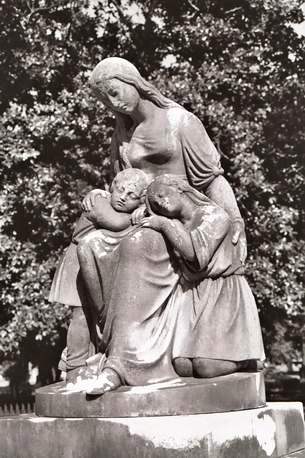 Lots of important people are buried at Magnolia Cemetery, including members of the Phinizy Family, for which Phinizy Swamp was named (see: Swampland I & II). Veterans of the Revolutionary War are also buried at the cemetery, including John Martin, who died in 1843 at the age of 105. The guy had even been wounded in the head by a tomahawk in the Cherokee War of 1755. Of course, lots of Confederate soldiers have their graves in Magnolia. Seven Confederate Generals are buried in the cemetery, although only a couple actually died in the war. The graves of many other soldiers are found in designated areas in the back of the cemetery. Some are simply marked, "UNKNOWN."
Lots of important people are buried at Magnolia Cemetery, including members of the Phinizy Family, for which Phinizy Swamp was named (see: Swampland I & II). Veterans of the Revolutionary War are also buried at the cemetery, including John Martin, who died in 1843 at the age of 105. The guy had even been wounded in the head by a tomahawk in the Cherokee War of 1755. Of course, lots of Confederate soldiers have their graves in Magnolia. Seven Confederate Generals are buried in the cemetery, although only a couple actually died in the war. The graves of many other soldiers are found in designated areas in the back of the cemetery. Some are simply marked, "UNKNOWN."
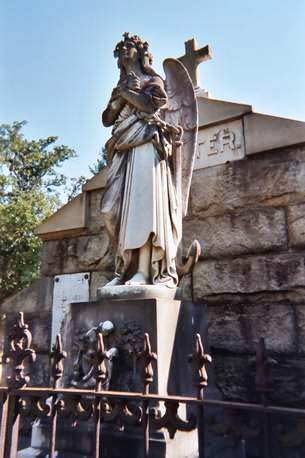 Wylly Barron, who controlled gambling in the Atkinson Hotel on Ellis St, is also buried in Magnolia. A gambler killed himself following heavy losses, but before he did he cursed Wylly, saying, "You have taken everything I have. When you die, may you not even have a grave to shelter you." This spooked Wylly and he started enforcing all sorts of regulations in his parlor to ease his conscience. People that handled money for their jobs couldn't gamble (they might steal), nor could minors. He also secretly gave money to anyone that had come upon hard luck and asked him for help. But, most importantly, he bought a mausoleum in Magnolia so he'd be certain there WOULD be a grave to shelter him. Good thing he did, too.
Wylly Barron, who controlled gambling in the Atkinson Hotel on Ellis St, is also buried in Magnolia. A gambler killed himself following heavy losses, but before he did he cursed Wylly, saying, "You have taken everything I have. When you die, may you not even have a grave to shelter you." This spooked Wylly and he started enforcing all sorts of regulations in his parlor to ease his conscience. People that handled money for their jobs couldn't gamble (they might steal), nor could minors. He also secretly gave money to anyone that had come upon hard luck and asked him for help. But, most importantly, he bought a mausoleum in Magnolia so he'd be certain there WOULD be a grave to shelter him. Good thing he did, too.
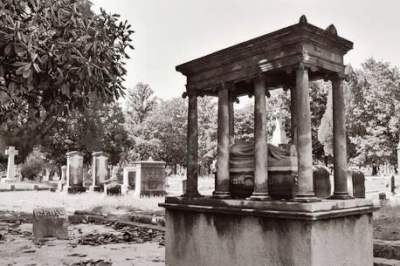
While Wylly Barron had led an extravagant life at one point, by his death at 88 he'd lost most of his wealth. Upon his death, he was so broke a proper coffin couldn't be purchased and his body was simply bricked into the mausoleum. The key to the mausoleum and surrounding fence was then thrown in the Savannah River, as he'd decreed in his will, so no one could ever pull him out of his grave later. His epitaph reads: “Farewell vain work, I know enough of thee. And now am careless what thou sayest of me. Thy smiles I court not, nor thy frowns I fear. My cares are past, my head lies quiet here. What faults you knew of me, take care to shun. And look at home, enough there’s to be done.” In the mid-to-late 1800's, people apparently didn't always take kindly to gamblers. Uh, this photo is not of his mausoleum.
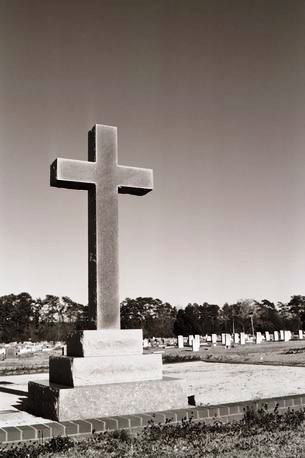 There's several other cemeteries in Augusta but I only visited one other. And how's this for lame? I don't even know the name of it. It's right by the canal, just behind Broad St. I can't find any listings for it anywhere. Perhaps it's a phantom cemetery, like the Flying Dutchman of boneyards. If that's the case, it's pretty big for a phantom cemetery. Whatever the case, this cemetery has some pretty mean-spirited insciptions on a few of its stones.
There's several other cemeteries in Augusta but I only visited one other. And how's this for lame? I don't even know the name of it. It's right by the canal, just behind Broad St. I can't find any listings for it anywhere. Perhaps it's a phantom cemetery, like the Flying Dutchman of boneyards. If that's the case, it's pretty big for a phantom cemetery. Whatever the case, this cemetery has some pretty mean-spirited insciptions on a few of its stones.
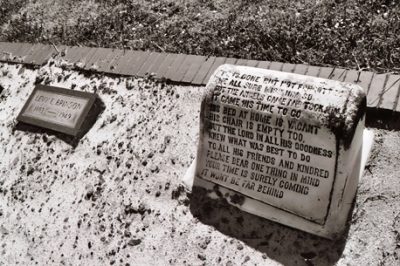
This one reads: "He is gone but not forgotten, we all sure miss him so. But the angels came and took him, it was his time to go. His bed at home his vacant, his chair is empty too. But the Lord in all his goodness, knew what was best to do. To all his friends and kindred, please bear one thing in mind. Your time is surely coming, it won't be far behind."

Or, if they're not mean-spirited, they sure do seem to be encouraging the reader to "PREPARE TO DIE!" "Pause here stranger, as you pass by. As you are now, so once was I. As I am now, so shall you be. Prepare for death, and follow me." Hey, nothing like a real life-affirming inscription, eh?
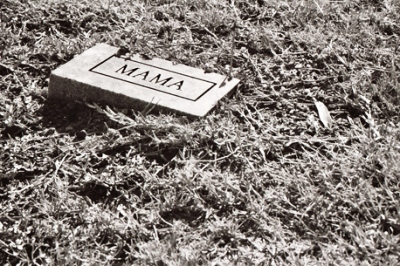
But I agree, sometimes the understated stone is the way to go. I hope everyone has a Happy Halloween. Such a nice holiday and a great way to prepare for the elections, huh? Next time we'll stick with the historical bent and check out the Augusta Canal, I think. Until then, enjoy your candy.
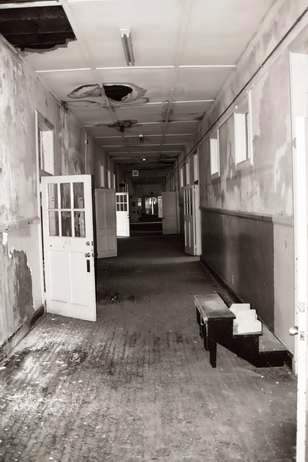 Okay, back to school. Up on the second floor of the John S. Davidson Magnet School for the Fine Arts things were falling apart. This is where it became really obvious they weren't going to salvage this building. Anyway, there were essentially no interesting objects lying around. No old apples, no textbooks, no hickory switches. Oh yeah, I guess this wasn't a Catholic school. Hey, just kidding! I admit that I got a good education from a Catholic school for a couple years when my mom was trying to find me a school that I might loathe only slightly. And, for the record, I don't recall ever being switched by a nun myself.
Okay, back to school. Up on the second floor of the John S. Davidson Magnet School for the Fine Arts things were falling apart. This is where it became really obvious they weren't going to salvage this building. Anyway, there were essentially no interesting objects lying around. No old apples, no textbooks, no hickory switches. Oh yeah, I guess this wasn't a Catholic school. Hey, just kidding! I admit that I got a good education from a Catholic school for a couple years when my mom was trying to find me a school that I might loathe only slightly. And, for the record, I don't recall ever being switched by a nun myself.
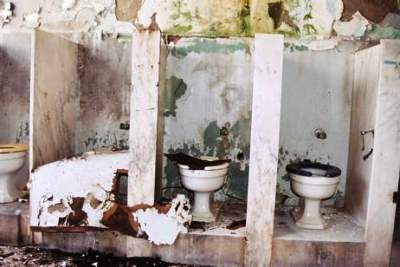
The bathrooms provided the most aesthetically interesting dilapidation. From left to right this photo perfectly documents the three stages of decay that your typical toilet stall goes through in its inevitable slide toward ultimate destruction. I hope everyone realizes how fortunate they are to see this phenomenon so completely laid out in its natural environment.
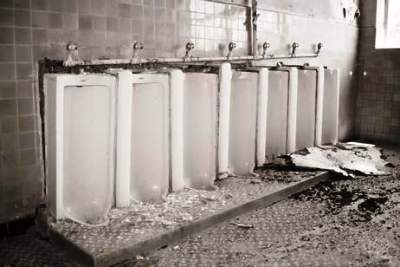 You know, I hated school as a kid. I mean, I REALLY hated school. From the time I started kindergarten until I finished high school I loathed getting up in the morning, dragging myself to the bus, and sitting in class all day. Seeing these urinals reminds me of those days of malice. I do take some comfort in the fact that they are just about destroyed. But still, I feel kinda nauseous just looking at them. In fact, I hated school so much what did I do? I got a master's degree. It doesn't even make sense to me.
You know, I hated school as a kid. I mean, I REALLY hated school. From the time I started kindergarten until I finished high school I loathed getting up in the morning, dragging myself to the bus, and sitting in class all day. Seeing these urinals reminds me of those days of malice. I do take some comfort in the fact that they are just about destroyed. But still, I feel kinda nauseous just looking at them. In fact, I hated school so much what did I do? I got a master's degree. It doesn't even make sense to me.

Here we have a couple of lonely, forgotten sinks. These sinks represent the impenetrable isolation of the individual (represented by the sinks) within society (represented by the bathroom). If only the sinks could touch one another or somehow communicate their feelings they might be able to change their lives for the better. However, note that the sinks, despite their shared plight, are even more isolated from the towel dispenser (which represents the universal "other"). Truly, this is a heavy picture.
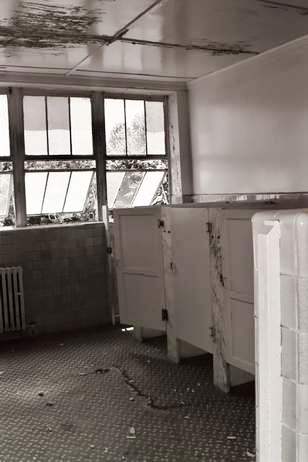 Back in school it was always exciting to somehow get into the girls bathroom and see what it looked like. One time one of my stupider classmates just waltzed in to see what was going on. This necessitated a school-wide announcement regarding the proper use of the bathroom by the respective genders. We were finally able to get it all sorted out and went on to become the well-adjusted adults we all undoubtedly are today.
Back in school it was always exciting to somehow get into the girls bathroom and see what it looked like. One time one of my stupider classmates just waltzed in to see what was going on. This necessitated a school-wide announcement regarding the proper use of the bathroom by the respective genders. We were finally able to get it all sorted out and went on to become the well-adjusted adults we all undoubtedly are today.
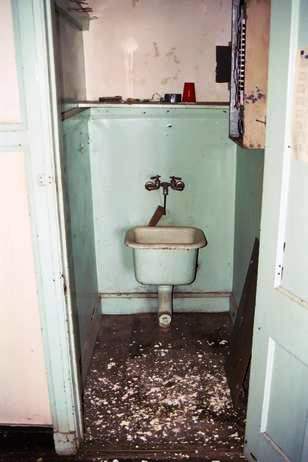 Now THIS wash basin symbolizes the rugged individualism of the American in the 21st Century. Didn't you always hate that when you'd read a book for class and they'd come up with all these hokey symbols and tell you the implied meaning of every incidental object? "Okay now, class, who realized that the dog in Old Yeller represented man's universal sorrow at the constant loss and painful change that consumes all our lives? I think this point was made obvious by the author's portrayal of the dog as a retriever." This was one reason why I didn't even really read a book until I was 18. Of course, if we'd hit Hubert Selby Jr. in 11th grade that might've been different. But try explaining that choice to parents on PTA night.
Now THIS wash basin symbolizes the rugged individualism of the American in the 21st Century. Didn't you always hate that when you'd read a book for class and they'd come up with all these hokey symbols and tell you the implied meaning of every incidental object? "Okay now, class, who realized that the dog in Old Yeller represented man's universal sorrow at the constant loss and painful change that consumes all our lives? I think this point was made obvious by the author's portrayal of the dog as a retriever." This was one reason why I didn't even really read a book until I was 18. Of course, if we'd hit Hubert Selby Jr. in 11th grade that might've been different. But try explaining that choice to parents on PTA night.

This is classic little kid graffiti. You can tell that it's the real deal by that little kid scrawl. Obviously, this was one of those home economics classes where kids role play different family members. This guy must've been the father. "Family, I'm sorry, but there's a reason we can't afford to eat tonight." Pretty realistic, I'd say. Also, what good would a school for the fine arts be if the students weren't taught the finer points of existential angst? The student writing at the top must've been at the head of his class. (It reads, "I have no reason to be here.")
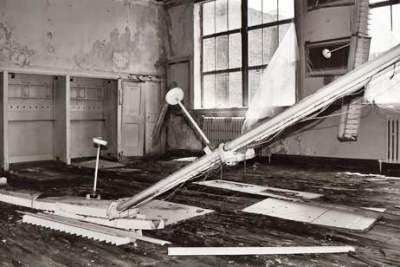
This classroom is the way I wished all my classrooms looked back in the day. Okay, I'll lighten up. I understand the value of a good education. But since hardly anyone gets one anymore what's the matter with railing a bit about it? Really, I hated being there. I enjoyed singing along to "Another Brick in the Wall" when I was little, but once I got a bit older The Replacements really nailed it for me with their classic ode to the classroom off the Stink 12".
 I feel like this post has gotten way out of hand. I really had nothing of historical or sociological interest to add regarding the school. I covered it all last time. So, I guess I got all bloggy and personal on ya. Oh well. In any case, this post is dedicated to the youngsters of the John S. Davidson Magnet School for the Fine Arts and their poor old building. And with that, I better go. ADDENDUM: Upon re-reading I find this to be the most embarrassing post ever submitted to City of Dust. And that might really be saying something. I can do nothing except offer my humble apologies. I let the text stand (almost) as written only as a warning to myself.
I feel like this post has gotten way out of hand. I really had nothing of historical or sociological interest to add regarding the school. I covered it all last time. So, I guess I got all bloggy and personal on ya. Oh well. In any case, this post is dedicated to the youngsters of the John S. Davidson Magnet School for the Fine Arts and their poor old building. And with that, I better go. ADDENDUM: Upon re-reading I find this to be the most embarrassing post ever submitted to City of Dust. And that might really be saying something. I can do nothing except offer my humble apologies. I let the text stand (almost) as written only as a warning to myself.
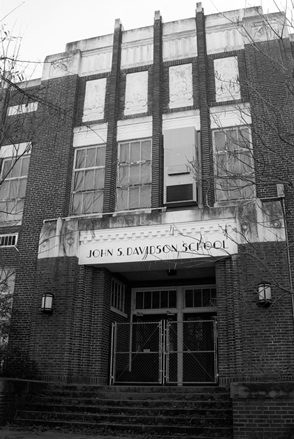 The John S. Davidson Magnet School for the Fine Arts is a school of some reknown in Augusta and, in fact, the nation. Teaching kids from grades 5-12, the school was voted the best high school in Georgia in 1996, and was one of only three high schools in Augusta to even make the top half. Lucy C. Laney High, just a few blocks away, was ranked the third worst in the state that same year. The school teaches drama, photography, and dance, among other things, and sounds like a darn nice place. However, the school has been at a new location for the last few years as the old building, at Telfair and 11th, was closed due to asbestos contamination. While from the front it looks like MAYBE someone is planning on cleaning it up, it's more likely that they're just waiting for the thing to fall down. Go around the back and there's nothing but broken windows and piles of old tires.
The John S. Davidson Magnet School for the Fine Arts is a school of some reknown in Augusta and, in fact, the nation. Teaching kids from grades 5-12, the school was voted the best high school in Georgia in 1996, and was one of only three high schools in Augusta to even make the top half. Lucy C. Laney High, just a few blocks away, was ranked the third worst in the state that same year. The school teaches drama, photography, and dance, among other things, and sounds like a darn nice place. However, the school has been at a new location for the last few years as the old building, at Telfair and 11th, was closed due to asbestos contamination. While from the front it looks like MAYBE someone is planning on cleaning it up, it's more likely that they're just waiting for the thing to fall down. Go around the back and there's nothing but broken windows and piles of old tires.
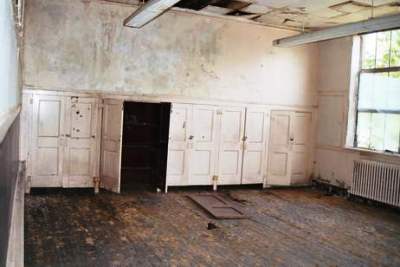
We'd been told that the Davidson School was well-known and well-populated since the water and electricity had been left on. This makes for a tricky situation. In fact, on our first visit, someone was behind the building standing around and yelling incoherently. We decided to abort that mission. Whenever there's a chance of encountering people you have to be very cautious. If I know a place is occupied, I usually won't explore it. I wouldn't want someone walking into my living room, particularly with a camera, and you have to respect the people that got there before you. It is, after all, their home.
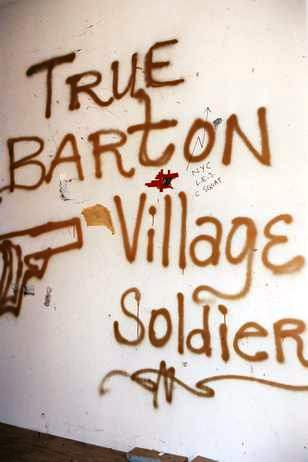 In this case, the Davidson School seemed large enough to warrant an entry. There was a good chance we wouldn't have to come face-to-face with anyone if we were careful and, really, it sounded like such a popular place that we might not even be noticed. Aside from staying away out of respect, there's usually no reason to avoid the homeless. If you come across someone, you acknowledge them and, if they tell you to leave, you leave. If they ask for some change or a cigarette you give them something. Often you might get some useful advice out of the exchange. There are, however, exceptions, and you have to use all the perception and intuition you've got in certain circumstances. Sometimes, if the vibes just ain't right, it's best to turn and walk (or run) away. You can't afford to come across the wrong person too many times. Usually the wrong person isn't a homeless person at all, but someone else. Oh yeah, when I say "you" I don't mean "YOU." Again, I don't recommend that anyone do this.
In this case, the Davidson School seemed large enough to warrant an entry. There was a good chance we wouldn't have to come face-to-face with anyone if we were careful and, really, it sounded like such a popular place that we might not even be noticed. Aside from staying away out of respect, there's usually no reason to avoid the homeless. If you come across someone, you acknowledge them and, if they tell you to leave, you leave. If they ask for some change or a cigarette you give them something. Often you might get some useful advice out of the exchange. There are, however, exceptions, and you have to use all the perception and intuition you've got in certain circumstances. Sometimes, if the vibes just ain't right, it's best to turn and walk (or run) away. You can't afford to come across the wrong person too many times. Usually the wrong person isn't a homeless person at all, but someone else. Oh yeah, when I say "you" I don't mean "YOU." Again, I don't recommend that anyone do this.
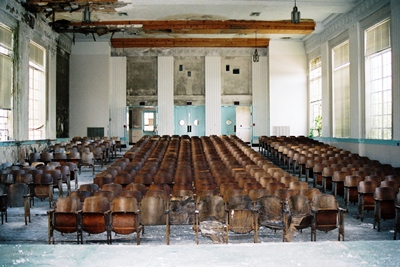
It looked like it should be a cinch to get in the school, but after trying my luck at every door and window and looking up and down (and under) I was about to give up. I had just turned to tell my companion that I didn't see an entrance when he waved at me from inside. It really WAS easy to get in, I was just looking for the hardest way.
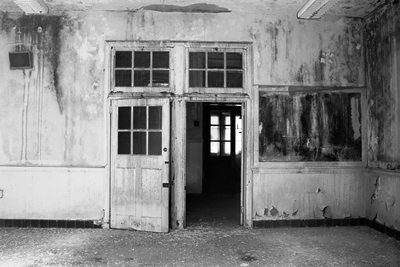
As it turned out, and a bit to our surprise (and relief), there wasn't a soul around. The drip-drip-drip of water from somewhere sounded like footsteps for a moment, but once we realized it wasn't a tenant we didn't see or hear anything else. This might be because at this point the building is in terrible condition in many places. Windows have been open for years, walls are collapsing, and ceilings have fallen in. Oddly though, we didn't see any evidence of anyone having EVER been inside for an extended time. No old clothing, no bottles, no magazines, not even much graffiti.
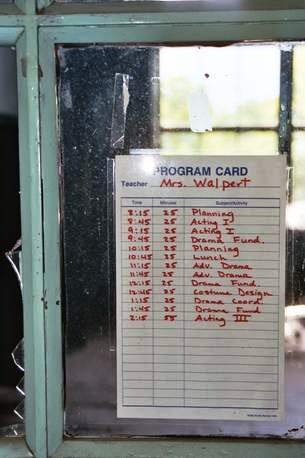 So where the hell was everyone? Who knows? The building had been closed because of asbestos, so maybe folks are just feeling a bit health conscious these days. It seems like the students hadn't been told they'd be going anywhere beforehand. Class schedules were still posted, lessons remained on the blackboards, and various flyers were still hung up. Hmm, I sure hope it was asbestos they found. Asbestos is generally harmless when exposure is very limited (i.e. one visit) and those holes in the wall gave us some ventilation. Still, it felt a bit like a mini-Chernobyl.
So where the hell was everyone? Who knows? The building had been closed because of asbestos, so maybe folks are just feeling a bit health conscious these days. It seems like the students hadn't been told they'd be going anywhere beforehand. Class schedules were still posted, lessons remained on the blackboards, and various flyers were still hung up. Hmm, I sure hope it was asbestos they found. Asbestos is generally harmless when exposure is very limited (i.e. one visit) and those holes in the wall gave us some ventilation. Still, it felt a bit like a mini-Chernobyl.
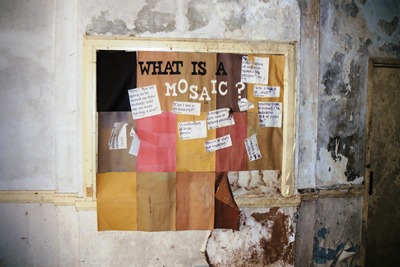
We had two full floors to explore and these pictures are all just the first. The first floor had the theater, a few classrooms, the cafeteria and kitchen, and the shop area. Large drill presses and band saws were still sitting about and I have no idea why they didn't take them with them when they moved. I'll post some photos from the second floor next time, which had more interesting classrooms, a darkroom, bathrooms, and some fine grade-school kid graffiti.
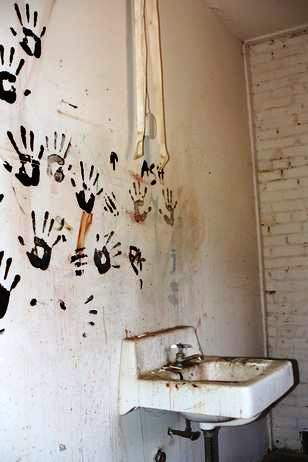 You come across homeless people frequently while walking down the empty streets of downtown Augusta and there have been some worthwhile books and films published about the homeless in recent years. Marc Singer's documentary, Dark Days, about a group of people living in an Amtrak tunnel in NYC, is intense and empathetic. It was even made by the people in the tunnel, which is a story in itself. Here's a pretty comprehensive review of the film, now on DVD. Incidentally, Mole People, by Jennifer Toth, a book purportedly about people residing in the subway tunnels in NYC, has come under fire as being at best inaccurate and at worst made up . Brennan's website documenting the tunnels themselves is really something. God's Movie, a film of interviews with homeless people along the beaches of LA, is also well-done and worth seeing. It was supposed to be Vol. 1, but I waited a few years for Vol. 2 and it never came out. Joe Cole, the filmmaker, was killed in a mugging in LA in 1991 shortly after filming some of the footage and it was compiled posthumously. Copies were once available through Henry Rollins' website. I also recommend Cormac McCarthy's "Suttree" for an astounding portrait of southern life on the fringes.
You come across homeless people frequently while walking down the empty streets of downtown Augusta and there have been some worthwhile books and films published about the homeless in recent years. Marc Singer's documentary, Dark Days, about a group of people living in an Amtrak tunnel in NYC, is intense and empathetic. It was even made by the people in the tunnel, which is a story in itself. Here's a pretty comprehensive review of the film, now on DVD. Incidentally, Mole People, by Jennifer Toth, a book purportedly about people residing in the subway tunnels in NYC, has come under fire as being at best inaccurate and at worst made up . Brennan's website documenting the tunnels themselves is really something. God's Movie, a film of interviews with homeless people along the beaches of LA, is also well-done and worth seeing. It was supposed to be Vol. 1, but I waited a few years for Vol. 2 and it never came out. Joe Cole, the filmmaker, was killed in a mugging in LA in 1991 shortly after filming some of the footage and it was compiled posthumously. Copies were once available through Henry Rollins' website. I also recommend Cormac McCarthy's "Suttree" for an astounding portrait of southern life on the fringes.
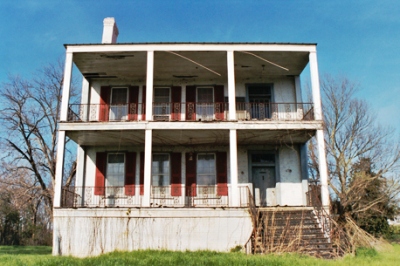
On the east end of Sand Bar Ferry, right by I-520, sits the Goodale Inn, formerly the head house of the Goodale Plantation, and built in the Federal style. Also known as the Hampton House or the Fitzsimmons House or some combination of the above, it was built in 1799. That makes it one of the oldest buildings in Augusta and it's on the National Register of Historic Places. Naturally, it's vacant and has been for some time, possibly because its nearest neighbor is the Columbia Nitrogen plant. See "Swampland" for a glimpse of the adjacent industrial landscape. On the other hand, it is offically for sale and occasionally there seems to be some work going on inside. At least, there's often a light left on. Yeah, I know. Ghosts.
Given its long history, the Goodale should be haunted. Dr. Paul Fitzsimmons Eve, an early Dean of the Medical College of GA, occupied the house while he lived in Augusta, from the early 1830's to 1850.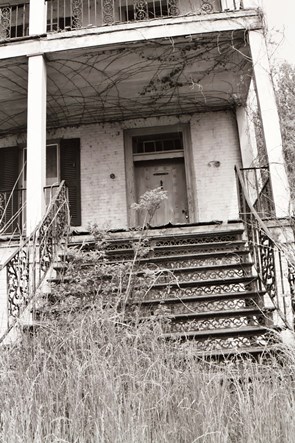 Eve was a participant in the Paris Revolution of 1830, served as a soldier and surgeon in the Polish Rebellion, and was a doctor for the Confederacy. He was also known for his hard stance against mesmerism. (The 18th century method of faith healing involving hypnotism and magnets pioneered by Dr. Mesmer, friend of Louis XVI and Marie Antoinette.) The Polish government eventually erected a statue in Augusta in his honor and put him on a stamp (for his role in the Rebellion, not the mesmerism thing...).
Eve was a participant in the Paris Revolution of 1830, served as a soldier and surgeon in the Polish Rebellion, and was a doctor for the Confederacy. He was also known for his hard stance against mesmerism. (The 18th century method of faith healing involving hypnotism and magnets pioneered by Dr. Mesmer, friend of Louis XVI and Marie Antoinette.) The Polish government eventually erected a statue in Augusta in his honor and put him on a stamp (for his role in the Rebellion, not the mesmerism thing...).
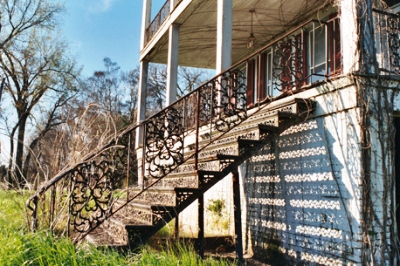
As far as I can tell, the "Hampton" of Hampton House refers to Wade Hampton III, a Lieutenant General in the Confederate Army and later Governor of South Carolina. Hampton was 42 when the Civil War began and took over the Confederate Calvary Corps at the behest of Robert E. Lee when JEB Stuart was killed in 1864. Hampton carried a four-foot long double-edged sword and on one occasion is said to have split a Union solider's skull to the chin with a single blow. After the war he told Ulysses S. Grant, "If we had known that you were going to back with bayonets the carpetbagger, the scalawag, and the negro in their infamous acts, we would never have given up our arms!" He was called the "Saviour of South Carolina" for railing against the policies of Reconstruction. Later, upon his death bed, in 1902, his last words were reportedly, "God bless all my people, black and white." Such is the conflicted history of the South.
I don't know much about another resident of the house, Jonathan Miller,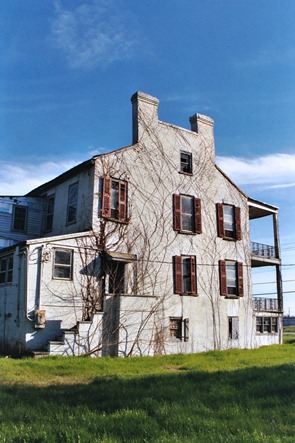 other than that he was Surgeon General of the Army of Tennessee. In the 1970's the house became a dinner club, sometimes featuring musical acts, run by a Mr. and Mrs. Harris. Word is that they made a mean beef stew and served A-1 prime rib. After that, it appears that some private owners occupied the place. I don't know when they left, but judging from the various debris lying around it was inhabited into the 1990's.
other than that he was Surgeon General of the Army of Tennessee. In the 1970's the house became a dinner club, sometimes featuring musical acts, run by a Mr. and Mrs. Harris. Word is that they made a mean beef stew and served A-1 prime rib. After that, it appears that some private owners occupied the place. I don't know when they left, but judging from the various debris lying around it was inhabited into the 1990's.
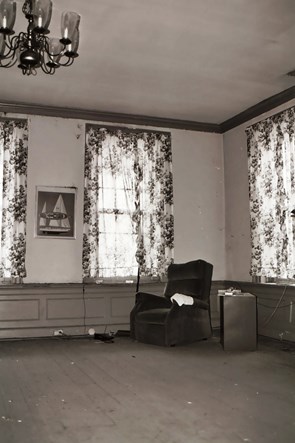 As I mentioned, the Inn is for sale (a steal at $129,500) and I wouldn't recommend that folks go into it for a variety of reasons. Yup, do as I say not as I do. But, if you want the best reason not to go in, it's this: It's boring. You'd think that a plantation house built in 1799 with 5 fireplaces and 10 rooms would be cool. Well, it's not. It's a bunch of square rooms, each featuring various amounts of dusty and dilapidated furniture. Trust me, I checked all three floors. Even the attic (a 200+ year-old attic!) was uninteresting.
As I mentioned, the Inn is for sale (a steal at $129,500) and I wouldn't recommend that folks go into it for a variety of reasons. Yup, do as I say not as I do. But, if you want the best reason not to go in, it's this: It's boring. You'd think that a plantation house built in 1799 with 5 fireplaces and 10 rooms would be cool. Well, it's not. It's a bunch of square rooms, each featuring various amounts of dusty and dilapidated furniture. Trust me, I checked all three floors. Even the attic (a 200+ year-old attic!) was uninteresting.
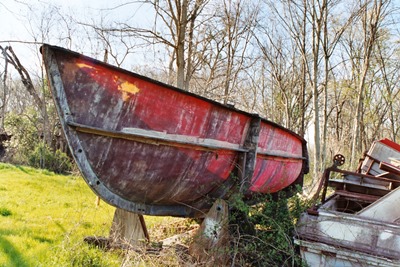
In back of the house are a bunch of abandoned boats. There's at least three, if I recall. The river is just over the levee, at the back of the yard, but then you'd have to go through the condos on the other side to get to the water. The builder of the condos must have been pretty confident about modern river control, I guess.
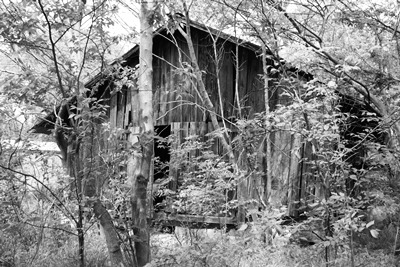
Next to the house are some old shacks. Right as I began to explore them my companion began having a severe allergic reaction on account of the Goodale's unmowed yard and waist-high grass. I wasn't about to miss a good shot just 'cause he couldn't breathe, so I looked around for a bit.
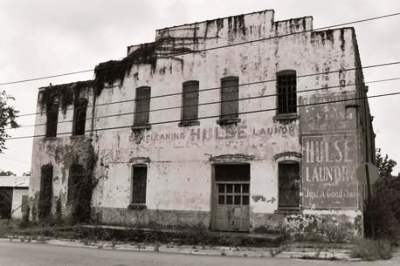
By the time Broad St. exits onto Washington Rd., on the far west side of downtown, it's all over. Washington Rd. signals the beginning of Augusta's mad dash to exhibit all that is wrong with America in the most gaudy and garish tones possible. And I'm not just saying that because Augusta National Golf Course is half a mile down the road. Laughably posted as a Scenic Byway (?!), Washington Rd. is a sprawling asphalt blight of Applebee's, Toyota dealerships, Hooter's, and several Kroger's. Naturally, I lived nearby. However, there are some interesting things off west Broad St., just before Washington Rd., including this old laundry/dry cleaning facility. I passed the back of this place on the John C. Calhoun Expressway everyday and wondered what it was. So, eventually, I went to have a look. Here it is, fronting onto Ellis St. Yup, THAT Ellis St., but much farther down, in a residential neighborhood. There didn't appear to be much inside and the lack of a roof (and, consequently, floor on the second story) made any attempt to get in seem sorta worthless.
 I also saw the burned-out roof of this house from up above via the John C. Calhoun on my way home each day. I couldn't figure out why they left what was clearly a destroyed home sitting in amongst the few other houses scattered about. So, I went to check it out. What I found was a little stretch of St. Luke St. tucked up against the pilings of the raised expressway. Barely a normal block in length, it was totally vacant. The house was filled with dozens of old tires.
I also saw the burned-out roof of this house from up above via the John C. Calhoun on my way home each day. I couldn't figure out why they left what was clearly a destroyed home sitting in amongst the few other houses scattered about. So, I went to check it out. What I found was a little stretch of St. Luke St. tucked up against the pilings of the raised expressway. Barely a normal block in length, it was totally vacant. The house was filled with dozens of old tires.
I mentioned that I don't take pictures of places where people live--and I don't. There's no one home at the place below and there hasn't been for some time. Actually, that's not strictly true. Occasionally there'd be people sleeping on the porch. I never got a chance to go inside for this reason--someone was always there before me. Except in this photo, when I was on my own and, I admit it, chickened out. Boo.
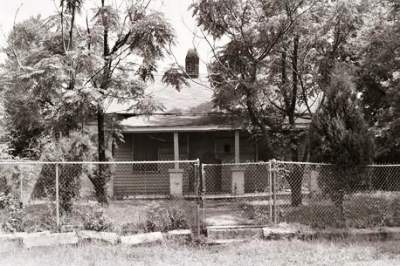
Below is the third and last house on what I saw of St. Luke St. In my "research" (yeah, searching Google) I found little mention of the street. According to the records of Magnolia Cemetery, Jasper Toole, a wood dealer, lived at 1317 St. Luke St., but died in February 1899 of LaGrippe (that's influenza, I guess). The only other listing is of a supply store somewhere on St. Luke selling everything from burglar alarms (wholesale) to cash registers. Geez, I sure didn't see it. Or maybe I did. Hmm. Anyway, there was some work being done on surrounding blocks and a couple old homes in particular looked like they were being seriously renovated. So maybe people will move back into this out-of-the-way corner. Still, it's probably no fun having the expressway rumbling overhead.
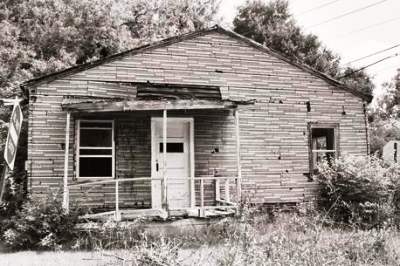
There are some other features of note off west Broad St. The Ezekiel Harris House, the second oldest structure in Augusta, is located there. Built in 1797, it's considered to be the finest example of Federal architecture in Georgia. Completely refurbished, it's open to the public as a museum. At least, it's supposed to be. I went there three or four times during what were supposed to be regular visiting hours and the place was always closed. Since it's set behind a tall white fence I don't have any street level photos either. It's supposedly haunted by various folks involved in the hanging of thirteen Colonialists by the English in 1780 at a spot nearby, but that hardly seems like a good excuse for never being open.

Also, the west side of Broad St. provides some of the best access to the Augusta Canal. The Augusta Canal and sites close by require more extensive posts of their own. We'll get to them, but other places beckon first.
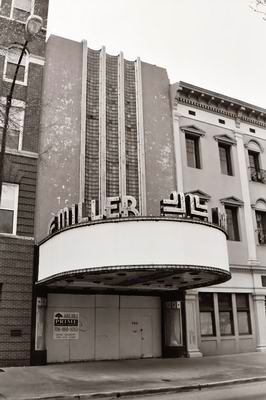 The Miller Theater is located at 7th and Broad St., right in downtown Augusta. Designed in 1938 and built for a reported $500,000, it seated 1600 people when it opened in 1940. It's been said that construction required a million bricks but only one (large) piece of carpeting. According to Cinema Treasures, the theater's architect was Roy A. Benjamin, who also built some theaters in Florida. The design is Arte Moderne (note the glass block and curved neon marquee) and the Miller represents the last theater of this type left standing in Georgia. Unfortunately, the Miller has been empty since 1984. An old flyer inside indicates that the Nutcracker was the last event held at the Miller, in the winter of '84.
The Miller Theater is located at 7th and Broad St., right in downtown Augusta. Designed in 1938 and built for a reported $500,000, it seated 1600 people when it opened in 1940. It's been said that construction required a million bricks but only one (large) piece of carpeting. According to Cinema Treasures, the theater's architect was Roy A. Benjamin, who also built some theaters in Florida. The design is Arte Moderne (note the glass block and curved neon marquee) and the Miller represents the last theater of this type left standing in Georgia. Unfortunately, the Miller has been empty since 1984. An old flyer inside indicates that the Nutcracker was the last event held at the Miller, in the winter of '84.
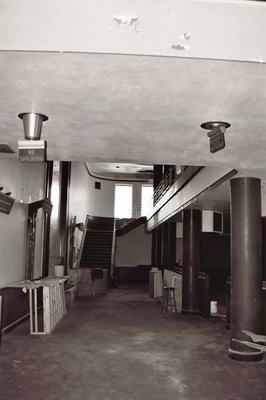 Before I go farther, let me say that we didn't "break" into the Miller. It's not that we mind getting arrested (har, har), it's just that the theater is a cool building and is also for sale. Hopefully, some entrepreneur will come along, buy the place, and rehabilitate it. We didn't want to jeopardize the building by looking for an entrance that might eventually allow other people to get in. One day we were out looking at some buildings nearby when we noticed something going on in the theater. Someone came out and asked us what we were up to. When we told him we were taking pictures of old buildings, he told us he was the realtor for the theater. Would we like to go inside? Of course, we would.
Before I go farther, let me say that we didn't "break" into the Miller. It's not that we mind getting arrested (har, har), it's just that the theater is a cool building and is also for sale. Hopefully, some entrepreneur will come along, buy the place, and rehabilitate it. We didn't want to jeopardize the building by looking for an entrance that might eventually allow other people to get in. One day we were out looking at some buildings nearby when we noticed something going on in the theater. Someone came out and asked us what we were up to. When we told him we were taking pictures of old buildings, he told us he was the realtor for the theater. Would we like to go inside? Of course, we would.
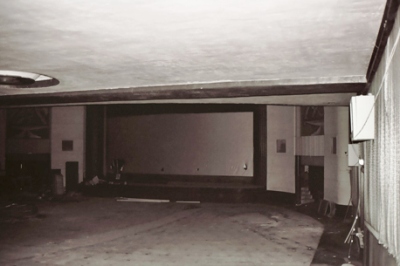
It's very dark inside and even with a flash and the realtor's help it was hard to get good pictures. There are large murals on either side of the screen, but we couldn't see them. Above us was the balcony seating. It's definitely a big theater, which you can't tell from its facade. In fact, once you enter, it curves to the right, so the screen is actually behind the building next door. Note the aluminum hand rails in the photo below. A lot of fingers have been dragged over those.
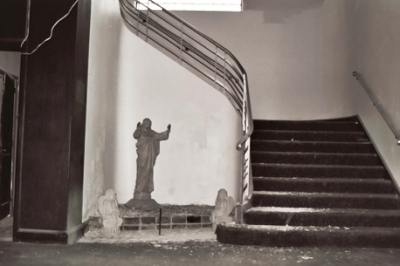
Just across from the Miller is another historic theater, the Imperial. According to Cinema Treasures, the Imperial opened in 1917 and was a big vaudeville playhouse. It was remodeled in the Art Deco style by Roy A. Benjamin in 1936 and eventually closed in 1981. In 1985 it reopened and has been hosting plays and concerts since. Also, it's been under renovation for that entire period. Money (not to mention an audience) is hard to come by for these old theaters and folks at the Imperial reportedly aren't too anxious to see the Miller reopen and compete for the same dollars it does. On the other hand, the Miller is so big that it probably couldn't survive as simply a movie theater and would need to have rock concerts, spoken word events, etc. to stay afloat. This is similar to what the Georgia Theater does in Athens. The Imperial has just started showing movies again and have a bang-up repertory schedule on-tap. I saw the jazz singer Jimmy Scott play an amazing show to a sold out crowd at the Imperial early this year, and it really is a great building in its own right.
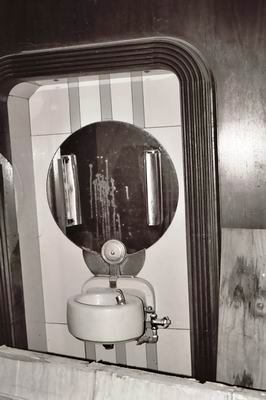 In the 20's and 30's Art Deco and Arte Moderne became very popular architectural styles. Both forms are spare and focus on geometry and curved ornamentation. Frankly, I have a hard time telling the difference. So, how do you tell them apart? Well, the City of Chicago sez: Art Moderne has a vertical orientation, featuring setbacks, geometric ornamentation, and colorful terra cotta. Art Deco has a horizontal orientation with rounded edges, corner windows, and glass block. So, since this drinking fountain has a vertical orientation, that must make it Arte Moderne, I guess.
In the 20's and 30's Art Deco and Arte Moderne became very popular architectural styles. Both forms are spare and focus on geometry and curved ornamentation. Frankly, I have a hard time telling the difference. So, how do you tell them apart? Well, the City of Chicago sez: Art Moderne has a vertical orientation, featuring setbacks, geometric ornamentation, and colorful terra cotta. Art Deco has a horizontal orientation with rounded edges, corner windows, and glass block. So, since this drinking fountain has a vertical orientation, that must make it Arte Moderne, I guess.
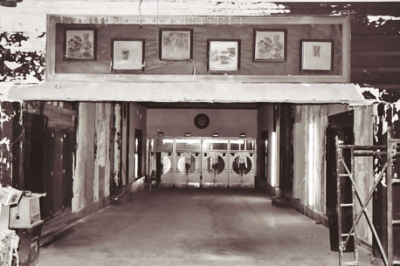
You can't see it from this photo, but the entire floor of this entryway is ornate terrazzo. In 1957 the world premiere of "The Three Faces of Eve" was held at the Miller. Joanne Woodward's family was apparently from North Augusta, SC, across the river. Also, the psychiatrists who wrote the original book were from Augusta. Pictures of the premiere and the Miller in all its glory can be found in various film books. It really is a beautiful theater, but 20 years of neglect is taking its toll. The realtor figured it had about 5 more years of vacancy before it would be a total loss. Wanna buy? Contact Prime Commercial Properties in Augusta, GA.
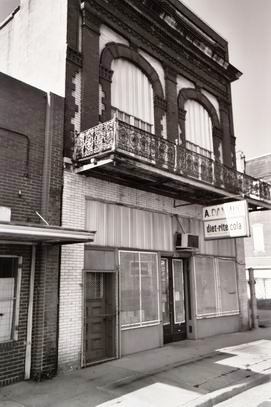 James Brown Boulevard (AKA 9th St.) has been called the last open streetscape in Augusta. I have no idea what that means, unless they're referring to the fact that you can nearly look from one end of it to the other. This is because there's nothing going on along most of the street. However, J.B. Blvd. does have some very nice old buildings, particularly along the stretch between Telfair St. and Walker St. Granted, that's only a block, but there's plenty of interest along that block and it really does feel "open".
James Brown Boulevard (AKA 9th St.) has been called the last open streetscape in Augusta. I have no idea what that means, unless they're referring to the fact that you can nearly look from one end of it to the other. This is because there's nothing going on along most of the street. However, J.B. Blvd. does have some very nice old buildings, particularly along the stretch between Telfair St. and Walker St. Granted, that's only a block, but there's plenty of interest along that block and it really does feel "open".
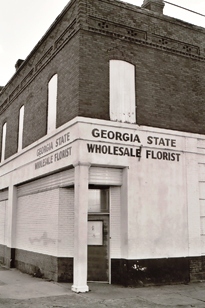 When I moved to Augusta I hoped at some point James Brown would make an appearance. I'd never seen the Godfather of Soul perform, and Augusta is his backyard. His yearly birthday bashes at the Augusta Civic Center had ceased some years before I arrived, but I held out hope. I can't condone some of the man's actions, but you can't argue with the tunes. So, naturally, I was excited when it was publicized that the Garden City Music Festival in downtown Augusta would be renamed the James Brown Music Festival, featuring the unveiling of a bronze statue of James and a free performance by the man himself. Hot damn.
When I moved to Augusta I hoped at some point James Brown would make an appearance. I'd never seen the Godfather of Soul perform, and Augusta is his backyard. His yearly birthday bashes at the Augusta Civic Center had ceased some years before I arrived, but I held out hope. I can't condone some of the man's actions, but you can't argue with the tunes. So, naturally, I was excited when it was publicized that the Garden City Music Festival in downtown Augusta would be renamed the James Brown Music Festival, featuring the unveiling of a bronze statue of James and a free performance by the man himself. Hot damn.
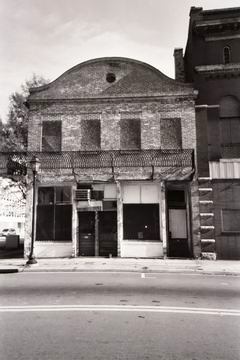 My excitement didn't last long as James was involved in another domestic dispute with his wife that had the police out at his residence one night. The city council, frequently embroiled in various morally dubious escapades themselves, decided NOT to change the festival's name, NOT to have James perform and, well, I don't have any clue what happened to the statue, which had been completed by that point. James responded by saying he didn't really need to have a festival named after him anyway and his mug shot didn't do him any favors either. Oh well, I think I ended up out of town the weekend of the festival.
My excitement didn't last long as James was involved in another domestic dispute with his wife that had the police out at his residence one night. The city council, frequently embroiled in various morally dubious escapades themselves, decided NOT to change the festival's name, NOT to have James perform and, well, I don't have any clue what happened to the statue, which had been completed by that point. James responded by saying he didn't really need to have a festival named after him anyway and his mug shot didn't do him any favors either. Oh well, I think I ended up out of town the weekend of the festival.
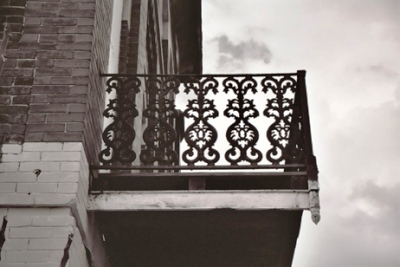
Many of the buildings on J.B. Blvd. have very ornate balconies, railings, and doors. Apparently one guy owns most of the buildings on this block and is supposedly refurbishing them. However, the southern climate is not kind to wood and there's usually mold, rotted timbers, warped pilings, and all sorts of hopeless problems. The city council recently even considered tearing everything on the block down to make way for the new municipal center pending a response by the owner of these buildings. The owner responded with something along the lines of, "I'm trying. Need more money." But, to their credit, the council also recognized the value of these historic structures. Whether that actually prevents them from being torn down, who knows?
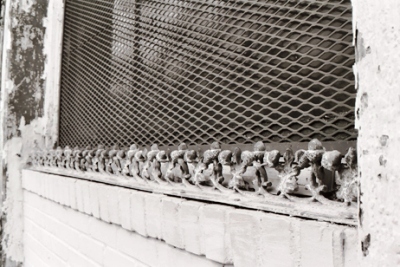
J.B. Blvd. runs from the river all the way across town to Laney-Walker. The area between downtown and Walton Way is nearly totally vacant at the moment. On the other end of town, people are generally advised to stay out of the handful of streets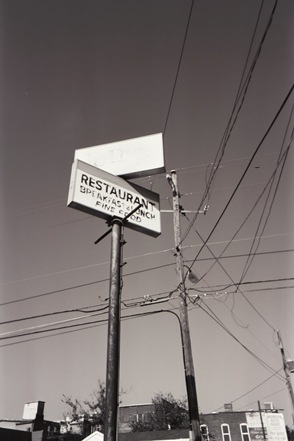 between Walton Way and Laney-Walker. I explored it a bit and these seemed to be neighborhoods of people just doing the best they could with what they had, like anyone. I didn't take any pictures of this stretch since it's lame to take pictures of places where people actually live. The places I photograph have some resonance with me, but I'm not fetishizing poverty or romanticizing economic misfortune. There's nothing "cool" or "edgy" about living below the poverty line. Actually, this isn't J.B. Blvd. at all, but a weather-beaten sign for Jolly's Restaurant at the corner of Ellis St. and 12th St. I just kinda like it. Next time we'll go to the movies.
between Walton Way and Laney-Walker. I explored it a bit and these seemed to be neighborhoods of people just doing the best they could with what they had, like anyone. I didn't take any pictures of this stretch since it's lame to take pictures of places where people actually live. The places I photograph have some resonance with me, but I'm not fetishizing poverty or romanticizing economic misfortune. There's nothing "cool" or "edgy" about living below the poverty line. Actually, this isn't J.B. Blvd. at all, but a weather-beaten sign for Jolly's Restaurant at the corner of Ellis St. and 12th St. I just kinda like it. Next time we'll go to the movies.
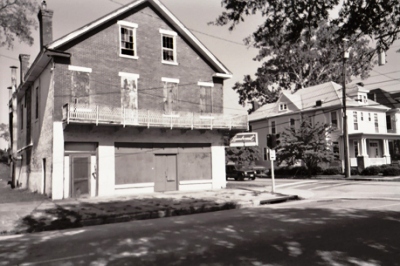
At the corner of Greene St. and 4th is this old laundromat/rooming house. Around the side are obscure painted signs indicating that everything from TV's to newspapers to fishing bait might have at one time been sold on the lower level. However, the top is a series of apartments configured in such a way as to make a person think this had once been a rooming house.
Normally sealed up tight as a drum, one day somebody thoughtfully kicked out the plywood covering the lower level entry. 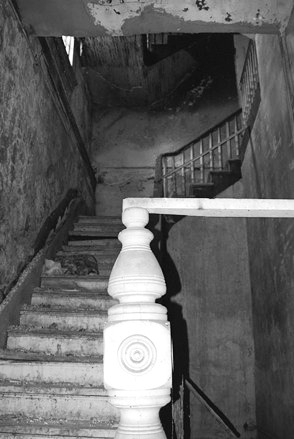 It took a few weeks for it to be sealed up again, but that was enough time to give it a looking over. As you walked through the doorway, this was the first thing you saw. Clearly, a dangerous wooden structure (rather than the preferred concrete or metal), but the stairs were very beckoning. I rarely explore alone, 'cause there's safety in numbers. But, also, it's useful to have someone around to run out and call 911 when their partner falls through the floor. That's a joke. Sorta.
It took a few weeks for it to be sealed up again, but that was enough time to give it a looking over. As you walked through the doorway, this was the first thing you saw. Clearly, a dangerous wooden structure (rather than the preferred concrete or metal), but the stairs were very beckoning. I rarely explore alone, 'cause there's safety in numbers. But, also, it's useful to have someone around to run out and call 911 when their partner falls through the floor. That's a joke. Sorta.

On the first floor were a number of apartments such as this one, most pretty much fully furnished. The rooms themselves seem to have been pretty nice, with real fireplaces and those windows would have provided great views of Greene St. The furnishings aren't exactly top-o'-the-line though and the rooms were all pitch dark. It was impossible to tell what was actually in the rooms until we saw the pictures, taken using a flash. There was an entrance to another entire section of the building on this floor, which would've probably more than doubled the size of this level, but we couldn't go through it as the floorboards were far too rotted out.
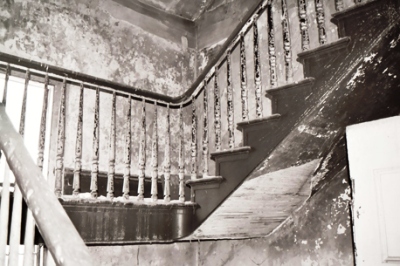 Next it was upstairs to the third floor. The stairs and walkways were some of the most interesting features of this building. Also, they were the most dangerous. You tread very gingerly on old wooden stairs, and even then you're never sure how solid the boards might be. After careful testing things seemed okay, so we continued.
Next it was upstairs to the third floor. The stairs and walkways were some of the most interesting features of this building. Also, they were the most dangerous. You tread very gingerly on old wooden stairs, and even then you're never sure how solid the boards might be. After careful testing things seemed okay, so we continued.
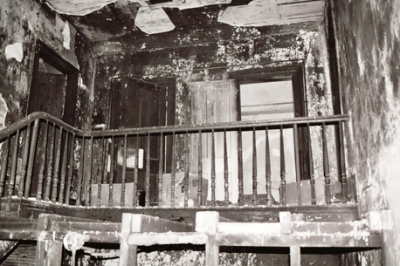
Above is a photo from the second floor landing. Yeah, that's fire damage, making things even more interesting. Also, this is where the pigeons were hanging out. There was lots of cooing and fluttering and, of course, lots of pigeon crap. Breathing the dust of pigeon droppings isn't so healthy, but by this point we were committed and, actually, there didn't seem to be much dust in the air. This was probably due to the size and variety of the holes in the walls and ceiling.
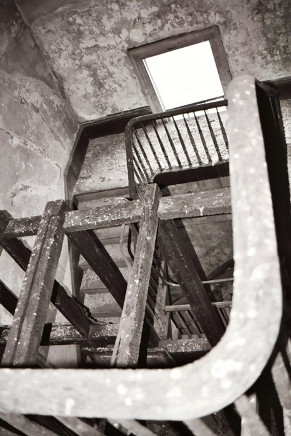 This is the view from the top of the stairs on the third floor. Again, these are really great stairs, eh? It must've been a pretty neat place to live once upon a time and I wish I knew SOMETHING about the building. But I don't. There was some train-hopper graffiti up on the third floor, so it's possible someone had lived here for a bit not too long ago. But this time there was no one home but the pigeons, who'd been busy roosting all over the place. From this angle, standing on questionable lumber, it's a long way down.
This is the view from the top of the stairs on the third floor. Again, these are really great stairs, eh? It must've been a pretty neat place to live once upon a time and I wish I knew SOMETHING about the building. But I don't. There was some train-hopper graffiti up on the third floor, so it's possible someone had lived here for a bit not too long ago. But this time there was no one home but the pigeons, who'd been busy roosting all over the place. From this angle, standing on questionable lumber, it's a long way down.
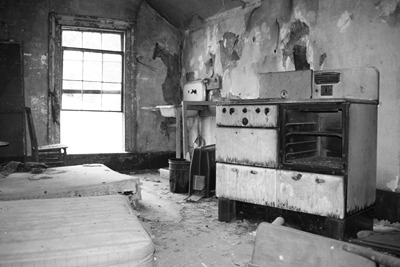
It's hard to tell if this attic kitchen was communal or if the stove in the photo above was simply installed in someone's bedroom, which is an interesting concept. Again, most of the furnishings were still in place, so people must've just walked away from a lot of their stuff. I don't know whether this would have been before or after the fire.
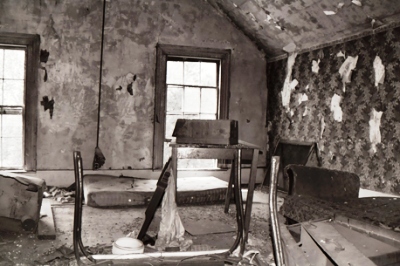
Another attic room offering a lovely view of the tree tops along Greene St. I wouldn't have minded staying here at all...about 40 years ago.
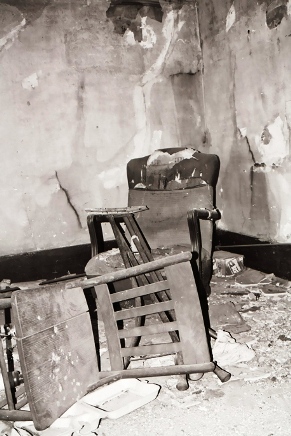 Dust, crutches, fallen plasterboard, and toppled chairs. It's the end of the line for this place, and probably, by this time, the people that lived here, as well. Shortly after our trip someone came around and put new plywood over all the windows and doors. What the ultimate fate of the house will be I don't know. Despite its previous glory(?), it's pretty much a total loss at this point. If the owner never physically tears it down it's probably just a matter of time until it falls to the ground all by itself.
Dust, crutches, fallen plasterboard, and toppled chairs. It's the end of the line for this place, and probably, by this time, the people that lived here, as well. Shortly after our trip someone came around and put new plywood over all the windows and doors. What the ultimate fate of the house will be I don't know. Despite its previous glory(?), it's pretty much a total loss at this point. If the owner never physically tears it down it's probably just a matter of time until it falls to the ground all by itself.
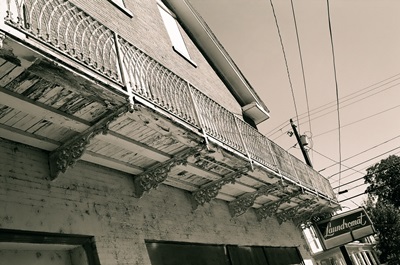
MARCH 2014 UPDATE: While doing some research for an exhibit and presentation at the 2012 Augusta Photography Festival I learned that this building at 401 Greene St. has long been known as Kahrs Grocery. On a 1904 Sanborn Fire Insurance Map the lot is designated as containing a store which also encompassed 403 Greene St. The upstairs must have been apartments even back then. A photo of the place apparently exists from the 1870’s and the building is believed to have been built by German immigrants before the Civil War, probably in the late-1850’s. That's much older than I had originally thought and REALLY COOL!
As of spring 2014, the Kahrs Grocery building persists, wounded but not yet beaten entirely.
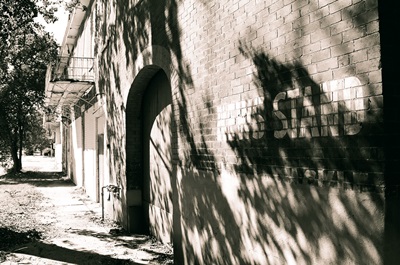
JULY 2014 UPDATE: I've now got a little more to add about the Kahrs Grocery story. The wholesale and retail grocery business was known as N. Kahrs & Co., established by Nicholas Kahrs in the 1850's. In 1881, Kahrs went into partnership with Fred Gehrken and Christian Richers, also German emigrants, and the following year he turned the entire enterprise over to them. But Kahrs was back in business by 1883, this time on Broad Street, most likely purchasing an alleyway and then adding some walls and a roof.
Kahrs, incidentally, was elected Police Commissioner of Augusta in 1885, at which time the Augusta Chronicle approvingly noted his success in business, adding that he was a "conservative, sagacious and popular citizen." He resigned in 1888, citing insufficient time to fulfill his duties. He did have ten children, after all. Nicholas Kahrs died in 1905, the Chronicle stating that "Mr. Kahrs was well known and his funeral will probably be largely attended."
Many thanks to Nick Kahrs, Nicholas Kahr's great, great grandson, for providing all this new information, as well as sending along the fantastic photo below, taken in the 1860's. Compare it to the photo at the top of this post to see about 140 years pass before your eyes. I believe the original resides with the Augusta Museum of History.
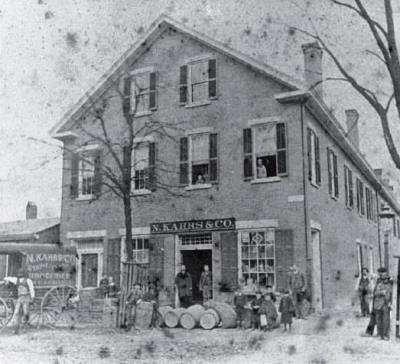
 There's several other cemeteries in Augusta but I only visited one other. And how's this for lame? I don't even know the name of it. It's right by the canal, just behind Broad St. I can't find any listings for it anywhere. Perhaps it's a phantom cemetery, like the Flying Dutchman of boneyards. If that's the case, it's pretty big for a phantom cemetery. Whatever the case, this cemetery has some pretty mean-spirited insciptions on a few of its stones.
There's several other cemeteries in Augusta but I only visited one other. And how's this for lame? I don't even know the name of it. It's right by the canal, just behind Broad St. I can't find any listings for it anywhere. Perhaps it's a phantom cemetery, like the Flying Dutchman of boneyards. If that's the case, it's pretty big for a phantom cemetery. Whatever the case, this cemetery has some pretty mean-spirited insciptions on a few of its stones.


 The John S. Davidson Magnet School for the Fine Arts is a school of some reknown in Augusta and, in fact, the nation. Teaching kids from grades 5-12, the school was voted the best high school in Georgia in 1996, and was one of only three high schools in Augusta to even make the top half. Lucy C. Laney High, just a few blocks away, was ranked the third worst in the state that same year. The school teaches drama, photography, and dance, among other things, and sounds like a darn nice place. However, the school has been at a new location for the last few years as the old building, at Telfair and 11th, was closed due to asbestos contamination. While from the front it looks like MAYBE someone is planning on cleaning it up, it's more likely that they're just waiting for the thing to fall down. Go around the back and there's nothing but broken windows and piles of old tires.
The John S. Davidson Magnet School for the Fine Arts is a school of some reknown in Augusta and, in fact, the nation. Teaching kids from grades 5-12, the school was voted the best high school in Georgia in 1996, and was one of only three high schools in Augusta to even make the top half. Lucy C. Laney High, just a few blocks away, was ranked the third worst in the state that same year. The school teaches drama, photography, and dance, among other things, and sounds like a darn nice place. However, the school has been at a new location for the last few years as the old building, at Telfair and 11th, was closed due to asbestos contamination. While from the front it looks like MAYBE someone is planning on cleaning it up, it's more likely that they're just waiting for the thing to fall down. Go around the back and there's nothing but broken windows and piles of old tires.
 In this case, the Davidson School seemed large enough to warrant an entry. There was a good chance we wouldn't have to come face-to-face with anyone if we were careful and, really, it sounded like such a popular place that we might not even be noticed. Aside from staying away out of respect, there's usually no reason to avoid the homeless. If you come across someone, you acknowledge them and, if they tell you to leave, you leave. If they ask for some change or a cigarette you give them something. Often you might get some useful advice out of the exchange. There are, however, exceptions, and you have to use all the perception and intuition you've got in certain circumstances. Sometimes, if the vibes just ain't right, it's best to turn and walk (or run) away. You can't afford to come across the wrong person too many times. Usually the wrong person isn't a homeless person at all, but someone else. Oh yeah, when I say "you" I don't mean "YOU." Again, I don't recommend that anyone do this.
In this case, the Davidson School seemed large enough to warrant an entry. There was a good chance we wouldn't have to come face-to-face with anyone if we were careful and, really, it sounded like such a popular place that we might not even be noticed. Aside from staying away out of respect, there's usually no reason to avoid the homeless. If you come across someone, you acknowledge them and, if they tell you to leave, you leave. If they ask for some change or a cigarette you give them something. Often you might get some useful advice out of the exchange. There are, however, exceptions, and you have to use all the perception and intuition you've got in certain circumstances. Sometimes, if the vibes just ain't right, it's best to turn and walk (or run) away. You can't afford to come across the wrong person too many times. Usually the wrong person isn't a homeless person at all, but someone else. Oh yeah, when I say "you" I don't mean "YOU." Again, I don't recommend that anyone do this.

 So where the hell was everyone? Who knows? The building had been closed because of asbestos, so maybe folks are just feeling a bit health conscious these days. It seems like the students hadn't been told they'd be going anywhere beforehand. Class schedules were still posted, lessons remained on the blackboards, and various flyers were still hung up. Hmm, I sure hope it was asbestos they found. Asbestos is generally harmless when exposure is very limited (i.e. one visit) and those holes in the wall gave us some ventilation. Still, it felt a bit like a mini-Chernobyl.
So where the hell was everyone? Who knows? The building had been closed because of asbestos, so maybe folks are just feeling a bit health conscious these days. It seems like the students hadn't been told they'd be going anywhere beforehand. Class schedules were still posted, lessons remained on the blackboards, and various flyers were still hung up. Hmm, I sure hope it was asbestos they found. Asbestos is generally harmless when exposure is very limited (i.e. one visit) and those holes in the wall gave us some ventilation. Still, it felt a bit like a mini-Chernobyl.


 Eve was a participant in the Paris Revolution of 1830, served as a soldier and surgeon in the Polish Rebellion, and was a doctor for the Confederacy. He was also known for his hard stance against mesmerism. (The 18th century method of faith healing involving hypnotism and magnets pioneered by Dr. Mesmer, friend of Louis XVI and Marie Antoinette.) The Polish government eventually erected a statue in Augusta in his honor and put him on a stamp (for his role in the Rebellion, not the mesmerism thing...).
Eve was a participant in the Paris Revolution of 1830, served as a soldier and surgeon in the Polish Rebellion, and was a doctor for the Confederacy. He was also known for his hard stance against mesmerism. (The 18th century method of faith healing involving hypnotism and magnets pioneered by Dr. Mesmer, friend of Louis XVI and Marie Antoinette.) The Polish government eventually erected a statue in Augusta in his honor and put him on a stamp (for his role in the Rebellion, not the mesmerism thing...).
 other than that he was Surgeon General of the Army of Tennessee. In the 1970's the house became a dinner club, sometimes featuring musical acts, run by a Mr. and Mrs. Harris. Word is that they made a mean beef stew and served A-1 prime rib. After that, it appears that some private owners occupied the place. I don't know when they left, but judging from the various debris lying around it was inhabited into the 1990's.
other than that he was Surgeon General of the Army of Tennessee. In the 1970's the house became a dinner club, sometimes featuring musical acts, run by a Mr. and Mrs. Harris. Word is that they made a mean beef stew and served A-1 prime rib. After that, it appears that some private owners occupied the place. I don't know when they left, but judging from the various debris lying around it was inhabited into the 1990's. As I mentioned, the Inn is for sale (a steal at $129,500) and I wouldn't recommend that folks go into it for a variety of reasons. Yup, do as I say not as I do. But, if you want the best reason not to go in, it's this: It's boring. You'd think that a plantation house built in 1799 with 5 fireplaces and 10 rooms would be cool. Well, it's not. It's a bunch of square rooms, each featuring various amounts of dusty and dilapidated furniture. Trust me, I checked all three floors. Even the attic (a 200+ year-old attic!) was uninteresting.
As I mentioned, the Inn is for sale (a steal at $129,500) and I wouldn't recommend that folks go into it for a variety of reasons. Yup, do as I say not as I do. But, if you want the best reason not to go in, it's this: It's boring. You'd think that a plantation house built in 1799 with 5 fireplaces and 10 rooms would be cool. Well, it's not. It's a bunch of square rooms, each featuring various amounts of dusty and dilapidated furniture. Trust me, I checked all three floors. Even the attic (a 200+ year-old attic!) was uninteresting.

 I also saw the burned-out roof of this house from up above via the John C. Calhoun on my way home each day. I couldn't figure out why they left what was clearly a destroyed home sitting in amongst the few other houses scattered about. So, I went to check it out. What I found was a little stretch of St. Luke St. tucked up against the pilings of the raised expressway. Barely a normal block in length, it was totally vacant. The house was filled with dozens of old tires.
I also saw the burned-out roof of this house from up above via the John C. Calhoun on my way home each day. I couldn't figure out why they left what was clearly a destroyed home sitting in amongst the few other houses scattered about. So, I went to check it out. What I found was a little stretch of St. Luke St. tucked up against the pilings of the raised expressway. Barely a normal block in length, it was totally vacant. The house was filled with dozens of old tires.


 The Miller Theater is located at 7th and Broad St., right in downtown Augusta. Designed in 1938 and built for a reported $500,000, it seated 1600 people when it opened in 1940. It's been said that construction required a million bricks but only one (large) piece of carpeting. According to
The Miller Theater is located at 7th and Broad St., right in downtown Augusta. Designed in 1938 and built for a reported $500,000, it seated 1600 people when it opened in 1940. It's been said that construction required a million bricks but only one (large) piece of carpeting. According to  Before I go farther, let me say that we didn't "break" into the Miller. It's not that we mind getting arrested (har, har), it's just that the theater is a cool building and is also for sale. Hopefully, some entrepreneur will come along, buy the place, and rehabilitate it. We didn't want to jeopardize the building by looking for an entrance that might eventually allow other people to get in. One day we were out looking at some buildings nearby when we noticed something going on in the theater. Someone came out and asked us what we were up to. When we told him we were taking pictures of old buildings, he told us he was the realtor for the theater. Would we like to go inside? Of course, we would.
Before I go farther, let me say that we didn't "break" into the Miller. It's not that we mind getting arrested (har, har), it's just that the theater is a cool building and is also for sale. Hopefully, some entrepreneur will come along, buy the place, and rehabilitate it. We didn't want to jeopardize the building by looking for an entrance that might eventually allow other people to get in. One day we were out looking at some buildings nearby when we noticed something going on in the theater. Someone came out and asked us what we were up to. When we told him we were taking pictures of old buildings, he told us he was the realtor for the theater. Would we like to go inside? Of course, we would.

 In the 20's and 30's Art Deco and Arte Moderne became very popular architectural styles. Both forms are spare and focus on geometry and curved ornamentation. Frankly, I have a hard time telling the difference. So, how do you tell them apart? Well, the
In the 20's and 30's Art Deco and Arte Moderne became very popular architectural styles. Both forms are spare and focus on geometry and curved ornamentation. Frankly, I have a hard time telling the difference. So, how do you tell them apart? Well, the 
 James Brown Boulevard (AKA 9th St.) has been called the last open streetscape in Augusta. I have no idea what that means, unless they're referring to the fact that you can nearly look from one end of it to the other. This is because there's nothing going on along most of the street. However, J.B. Blvd. does have some very nice old buildings, particularly along the stretch between Telfair St. and Walker St. Granted, that's only a block, but there's plenty of interest along that block and it really does feel "open".
James Brown Boulevard (AKA 9th St.) has been called the last open streetscape in Augusta. I have no idea what that means, unless they're referring to the fact that you can nearly look from one end of it to the other. This is because there's nothing going on along most of the street. However, J.B. Blvd. does have some very nice old buildings, particularly along the stretch between Telfair St. and Walker St. Granted, that's only a block, but there's plenty of interest along that block and it really does feel "open". When I moved to Augusta I hoped at some point James Brown would make an appearance. I'd never seen the Godfather of Soul perform, and Augusta is his backyard. His yearly birthday bashes at the Augusta Civic Center had ceased some years before I arrived, but I held out hope. I can't condone some of the man's actions, but you can't argue with the tunes. So, naturally, I was excited when it was publicized that the Garden City Music Festival in downtown Augusta would be renamed the James Brown Music Festival, featuring the unveiling of a bronze statue of James and a free performance by the man himself. Hot damn.
When I moved to Augusta I hoped at some point James Brown would make an appearance. I'd never seen the Godfather of Soul perform, and Augusta is his backyard. His yearly birthday bashes at the Augusta Civic Center had ceased some years before I arrived, but I held out hope. I can't condone some of the man's actions, but you can't argue with the tunes. So, naturally, I was excited when it was publicized that the Garden City Music Festival in downtown Augusta would be renamed the James Brown Music Festival, featuring the unveiling of a bronze statue of James and a free performance by the man himself. Hot damn. My excitement didn't last long as James was involved in another domestic dispute with his wife that had the police out at his residence one night. The city council, frequently embroiled in various morally dubious escapades themselves, decided NOT to change the festival's name, NOT to have James perform and, well, I don't have any clue what happened to the statue, which had been completed by that point. James responded by saying he didn't really need to have a festival named after him anyway and his mug shot didn't do him any favors either. Oh well, I think I ended up out of town the weekend of the festival.
My excitement didn't last long as James was involved in another domestic dispute with his wife that had the police out at his residence one night. The city council, frequently embroiled in various morally dubious escapades themselves, decided NOT to change the festival's name, NOT to have James perform and, well, I don't have any clue what happened to the statue, which had been completed by that point. James responded by saying he didn't really need to have a festival named after him anyway and his mug shot didn't do him any favors either. Oh well, I think I ended up out of town the weekend of the festival.

 between Walton Way and Laney-Walker. I explored it a bit and these seemed to be neighborhoods of people just doing the best they could with what they had, like anyone. I didn't take any pictures of this stretch since it's lame to take pictures of places where people actually live. The places I photograph have some resonance with me, but I'm not fetishizing poverty or romanticizing economic misfortune. There's nothing "cool" or "edgy" about living below the poverty line. Actually, this isn't J.B. Blvd. at all, but a weather-beaten sign for Jolly's Restaurant at the corner of Ellis St. and 12th St. I just kinda like it. Next time we'll go to the movies.
between Walton Way and Laney-Walker. I explored it a bit and these seemed to be neighborhoods of people just doing the best they could with what they had, like anyone. I didn't take any pictures of this stretch since it's lame to take pictures of places where people actually live. The places I photograph have some resonance with me, but I'm not fetishizing poverty or romanticizing economic misfortune. There's nothing "cool" or "edgy" about living below the poverty line. Actually, this isn't J.B. Blvd. at all, but a weather-beaten sign for Jolly's Restaurant at the corner of Ellis St. and 12th St. I just kinda like it. Next time we'll go to the movies.

 It took a few weeks for it to be sealed up again, but that was enough time to give it a looking over. As you walked through the doorway, this was the first thing you saw. Clearly, a dangerous wooden structure (rather than the preferred concrete or metal), but the stairs were very beckoning. I rarely explore alone, 'cause there's safety in numbers. But, also, it's useful to have someone around to run out and call 911 when their partner falls through the floor. That's a joke. Sorta.
It took a few weeks for it to be sealed up again, but that was enough time to give it a looking over. As you walked through the doorway, this was the first thing you saw. Clearly, a dangerous wooden structure (rather than the preferred concrete or metal), but the stairs were very beckoning. I rarely explore alone, 'cause there's safety in numbers. But, also, it's useful to have someone around to run out and call 911 when their partner falls through the floor. That's a joke. Sorta.
 Next it was upstairs to the third floor. The stairs and walkways were some of the most interesting features of this building. Also, they were the most dangerous. You tread very gingerly on old wooden stairs, and even then you're never sure how solid the boards might be. After careful testing things seemed okay, so we continued.
Next it was upstairs to the third floor. The stairs and walkways were some of the most interesting features of this building. Also, they were the most dangerous. You tread very gingerly on old wooden stairs, and even then you're never sure how solid the boards might be. After careful testing things seemed okay, so we continued.
 This is the view from the top of the stairs on the third floor. Again, these are really great stairs, eh? It must've been a pretty neat place to live once upon a time and I wish I knew SOMETHING about the building. But I don't. There was some train-hopper graffiti up on the third floor, so it's possible someone had lived here for a bit not too long ago. But this time there was no one home but the pigeons, who'd been busy roosting all over the place. From this angle, standing on questionable lumber, it's a long way down.
This is the view from the top of the stairs on the third floor. Again, these are really great stairs, eh? It must've been a pretty neat place to live once upon a time and I wish I knew SOMETHING about the building. But I don't. There was some train-hopper graffiti up on the third floor, so it's possible someone had lived here for a bit not too long ago. But this time there was no one home but the pigeons, who'd been busy roosting all over the place. From this angle, standing on questionable lumber, it's a long way down.

 Dust, crutches, fallen plasterboard, and toppled chairs. It's the end of the line for this place, and probably, by this time, the people that lived here, as well. Shortly after our trip someone came around and put new plywood over all the windows and doors. What the ultimate fate of the house will be I don't know. Despite its previous glory(?), it's pretty much a total loss at this point. If the owner never physically tears it down it's probably just a matter of time until it falls to the ground all by itself.
Dust, crutches, fallen plasterboard, and toppled chairs. It's the end of the line for this place, and probably, by this time, the people that lived here, as well. Shortly after our trip someone came around and put new plywood over all the windows and doors. What the ultimate fate of the house will be I don't know. Despite its previous glory(?), it's pretty much a total loss at this point. If the owner never physically tears it down it's probably just a matter of time until it falls to the ground all by itself.

